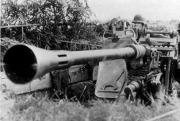Friendly Fire Pack 7

Friendly Fire Pack 7 contains eight scenarios featured in the Friendly Fire 2011 ASL tournament.
Scenarios: 8
Year of Publication: 2011
Price: 110 SEK (~10 USD)
Average Scenario ROAR Recommendation: 6.0
Average Scenario ROAR Balance: 33% - 67%
FrF53 Raid into the Reich

Birkenberg, East Prussia, Germany, September 4, 1939: The Polish Operational Group Narew was tasked to defend the north-eastern front line near the Lithuanian border, and prevent any German forces springing out of East Prussia from crossing the Narew and Biebrza rivers. Three days into the conflict, Narew's front were still quiet, and the Polish high command approved a raid into East Prussia, in hope that an eventual German counter-action would reveal their strength. At the small town of Birkenberg the Polish Podlaska Cavalry Brigade crashed into the German border defenses.
Designer: Mattias Rönnblom
ROAR Recommendation: 6.27
ROAR Record: German 32 (70%) - Polish 14 (30%)
FrF54 KNIL Before the Emperor

Ngandjoek, Netherlands East Indies, March 5, 1942: The Japanese had landed at Kragan, Eastern Java. The Tjepoe Raiding Unit under Colonel Tanaka occupied Tjepoe, but found its oilfields and bridge destroyed by the retreating KNIL (Dutch East Indies Army). On March 5, Tanaka's veterans of the Philippines campaign approached the road bridge at Ngandjoek, hot on the heels of a retreating KNIL unit. Across the river, a detachment of nearly 40 Dutch Marines, commanded by 1st Lieutenant Nas, were determined to put up a fight.
Designers:
- Peter Struijf
- Chris Mazzei
ROAR Recommendation: 6.37
ROAR Record: Dutch 18 (39%) - Japanese 28 (61%)
FrF55 Forsthaus Clash

The Forsthaus, northeast of Sevastopol, Crimea, June 10, 1942: On 7 June, the Germans broke through Sevastopol's outer defensive ring. Three days later, Mekenziyevy Mountain train station and a nearby road junction known as the Forsthaus (Forester's House) were captured. The Russian 79th Naval Infantry Brigade was ordered to counterattack and wrest back control of the Forsthaus. The black-clad sailors, well armed with modern semi-automatic rifles, sub-machine and light machine-guns, advanced confidently towards the German outpost line.
Designers:
- Peter Struijf
- Chris Mazzei
ROAR Recommendation: 5.56
ROAR Record: German 28 (74%) - Russian 10 (26%)
Errata: The StuG B is a StuG IIIB.
FrF56 Saluting a General

South of Karmanovo, Russia, September 4, 1942: In August 1942 the Red Army attempted to retake Rzhev and eliminate the most dangerous threat to the Russian capital. After almost a month of relentless attacks and bitter fighting, the Red Army had made only very small gains. On 4 September the Russian 153rd Tank Brigade and its lend-lease tanks struck and broke through the 78. Infanterie-Division's defenses in the wooded area south of Karmanovo. Attempting to seal the breach was German infantry supported by long-barrelled Panzer IIIs from the 2. Panzer-Division.
Designer: Mattias Rönnblom
ROAR Recommendation: 5.73
ROAR Record: German 12 (32%) - Russian 25 (68%)
FrF57 Warsaw in Flames

Warsaw, Poland, August 7, 1944: On 1 August, the Polish Home Army launched its much-anticipated Rising against the Germans in Warsaw. Some 40,000 insurgents fanned out across the city. The Wehrmacht, heavily engaged against Russian forces outside the city, insisted the Warsaw Rising be dealt with by the SS. Himmler ordered the formation of a special anti-insurgent corps, including “SS-Sturmbrigade Dirlewanger”, an infamous anti-partisan unit made up of former poachers and released violent criminals. The brigade was deployed against the insurgents blocking the western City Center.
Designers:
- Peter Struijf
- Chris Mazzei
ROAR Recommendation: 5.17
ROAR Record: German 11 (85%) - Partisan 2 (15%)
FrF58 Order 831

Königsberg an der Oder, Germany, February 4, 1945: As the Russian 1st Belorussian Front reached the Oder river, units of the newly-formed Heeresgruppe Weichsel were issued their marching orders. Himmler's order number 831 reached no-one less than the infamous Obersturmbannführer Otto Skorzeny, in charge of the SS-Jagdverbände. Skorzeny was to form a bridgehead east of the Oder large enough to fit retreating units - all in preperation of a counter offensive. The Russians soon realized the danger of the bridgehead and its intact bridge, and it was repeatedly attacked.
Designer: Michael Koch
ROAR Recommendation: 6.25
ROAR Record: German 53 (56%) - Russian 41 (44%)
FrF59 Capital Punishment

Neu Glietzen, Germany, April 16, 1945: In mid-April 1945, the time had come for the Red Army to cross the last major natural obstacle before Berlin - the Oder river. One of the many planned crossings was the 61st Army's effort to get the 8th Penal Battalion across to the south side of a destroyed rail bridge near the town Neu Glietzen. The penal units were made up of ex-POWs deemed not trustworthy, political prisoners and soldiers who had conducted "unauthorized retreats". Preparations were hasty, and the crossing was to be done in boats of make-shift construction.
Designer: Mattias Rönnblom
ROAR Recommendation: 6.65
ROAR Record: German 4 (27%) - Russian 11 (73%)
FrF60 A War of Their Own

Hill 171, Shumshu, Kuril Islands, August 18, 1945: Shumshu is the northernmost of the Kuril Islands in the Western Pacific near Kamchatka. In mid-August 1945, just after the Japanese surrender, the Russians set out to seize the island. The instructions that had been given to the surrendering Japanese forces left room for self-defense. The local commanders felt that the defense of the island constituted such self-defense and decided to continue the war on their own. Under their command was a powerful force with six battalions of infantry, naval and field artillery and a tank regiment.
Designer: Mattias Rönnblom
ROAR Recommendation: 5.61
ROAR Record: Japanese 14 (50%) - Russian 14 (50%)